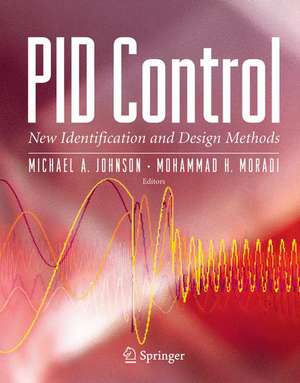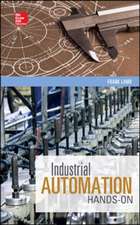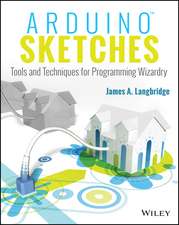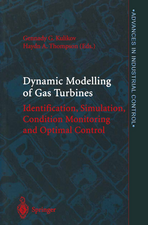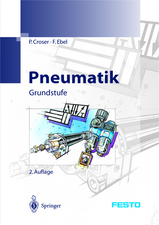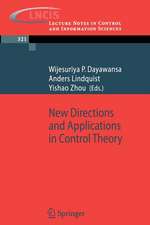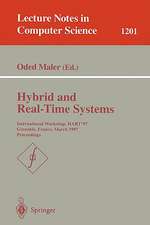PID Control: New Identification and Design Methods
Editat de Michael A. Johnson, Mohammad H. Moradien Limba Engleză Hardback – 17 iun 2005
| Toate formatele și edițiile | Preț | Express |
|---|---|---|
| Paperback (1) | 963.77 lei 6-8 săpt. | |
| SPRINGER LONDON – 13 oct 2010 | 963.77 lei 6-8 săpt. | |
| Hardback (1) | 968.65 lei 6-8 săpt. | |
| SPRINGER LONDON – 17 iun 2005 | 968.65 lei 6-8 săpt. |
Preț: 968.65 lei
Preț vechi: 1181.28 lei
-18% Nou
Puncte Express: 1453
Preț estimativ în valută:
185.38€ • 192.82$ • 153.04£
185.38€ • 192.82$ • 153.04£
Carte tipărită la comandă
Livrare economică 15-29 aprilie
Preluare comenzi: 021 569.72.76
Specificații
ISBN-13: 9781852337025
ISBN-10: 1852337028
Pagini: 572
Ilustrații: XXVIII, 544 p.
Dimensiuni: 191 x 235 x 36 mm
Greutate: 1.11 kg
Ediția:2005
Editura: SPRINGER LONDON
Colecția Springer
Locul publicării:London, United Kingdom
ISBN-10: 1852337028
Pagini: 572
Ilustrații: XXVIII, 544 p.
Dimensiuni: 191 x 235 x 36 mm
Greutate: 1.11 kg
Ediția:2005
Editura: SPRINGER LONDON
Colecția Springer
Locul publicării:London, United Kingdom
Public țintă
ResearchCuprins
PID Control Technology.- Some PID Control Fundamentals.- On-line Model-Free Methods.- Automatic PID Controller Tuning — the Nonparametric Approach.- Relay Experiments for Multivariable Systems.- Phase-Locked Loop Methods.- Phase-Locked Loop Methods and PID Control.- Process Reaction Curve and Relay Methods Identification and PID Tuning.- Fuzzy Logic and Genetic Algorithm Methods in PID Tuning.- Tuning PID Controllers Using Subspace Identification Methods.- Design of Multi-Loop and Multivariable PID Controllers.- Restricted Structure Optimal Control.- Predictive PID Control.
Textul de pe ultima copertă
The effectiveness of proportional-integral-derivative (PID) controllers for a large class of process systems has ensured their continued and widespread use in industry. Similarly there has been a continued interest from academia in devising new ways of approaching the PID tuning problem.
To the industrial engineer and many control academics this work has previously appeared fragmented; but a key determinant of this literature is the type of process model information used in the PID tuning methods. PID Control presents a set of coordinated contributions illustrating methods, old and new, that cover the range of process model assumptions systematically. After a review of PID technology, these contributions begin with model-free methods, progress through non-parametric model methods (relay experiment and phase-locked-loop procedures), visit fuzzy-logic- and genetic-algorithm-based methods; introduce a novel subspace identification method before closing with an interesting set of parametric model techniques including a chapter on predictive PID controllers. Highlights of PID Control include:
an introduction to PID control technology features and typical industrial implementations;
chapter contributions ordered by the increasing quality of the model information used;
novel PID control concepts for multivariable processes.
PID Control will be useful to industry-based engineers wanting a better understanding of what is involved in the steps to a new generation of PID controller techniques. Academics wishing to have a broader perspective of PID control research and development will find useful pedagogical material and research ideas in this text.
To the industrial engineer and many control academics this work has previously appeared fragmented; but a key determinant of this literature is the type of process model information used in the PID tuning methods. PID Control presents a set of coordinated contributions illustrating methods, old and new, that cover the range of process model assumptions systematically. After a review of PID technology, these contributions begin with model-free methods, progress through non-parametric model methods (relay experiment and phase-locked-loop procedures), visit fuzzy-logic- and genetic-algorithm-based methods; introduce a novel subspace identification method before closing with an interesting set of parametric model techniques including a chapter on predictive PID controllers. Highlights of PID Control include:
an introduction to PID control technology features and typical industrial implementations;
chapter contributions ordered by the increasing quality of the model information used;
novel PID control concepts for multivariable processes.
PID Control will be useful to industry-based engineers wanting a better understanding of what is involved in the steps to a new generation of PID controller techniques. Academics wishing to have a broader perspective of PID control research and development will find useful pedagogical material and research ideas in this text.
